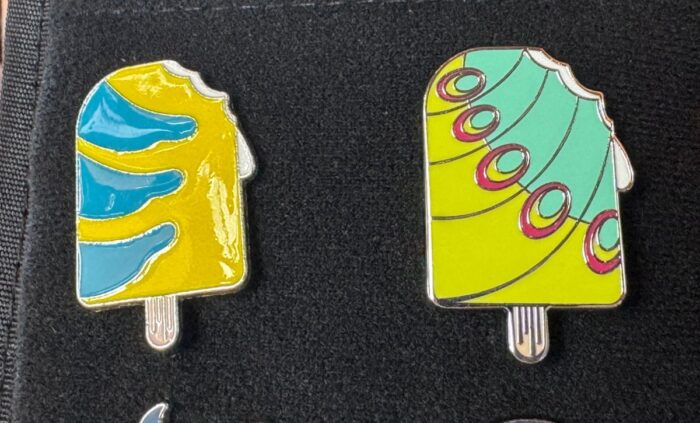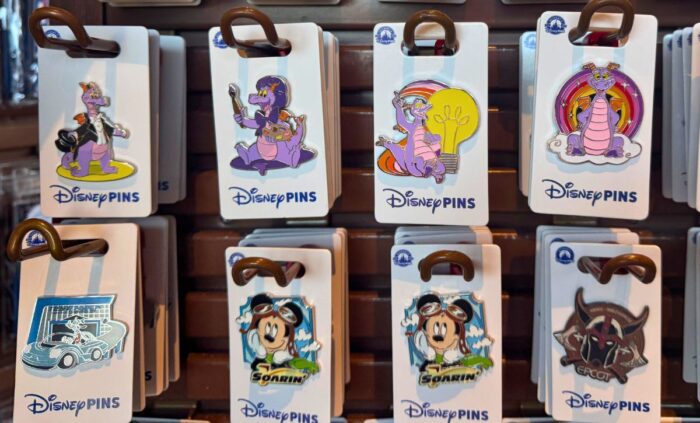
Disney in a Minute: What is Pin Trading?
Is it giving away the punchline to say that pin trading is trading pins? Probably. But since we’re here to talk about Disney definitions, we aren’t just talking about any pins. We’re talking Disney pins: enamel pins decorated with images of Disney, Pixar, Marvel, or Star Wars entities. They can feature characters, TV or film themes, or even theme park locations.
Sold in some kiosks and at every gift shop at the theme parks and cruise ships, prices can range from about $13 to $20 for a single pin. Sets can sell for $25-40, depending on the size, intricacy, and rarity of the pins. The variety is nearly endless, but a pin with the specific character or theme you’re looking for may not be on sale, because the images featured on pins rotate out and change frequently.
Guests can trade pins from lanyards around their necks (these are also available for purchase in the parks), special padded binder books, or via other creative means of display (we’ve seen people wearing hats and vests with literally every square inch covered with pins). Cast Members typically trade pins from lanyards or trading boards. You’ll find traders in various places throughout Disney World, but especially outside and around Spaceship Earth, and to either side of the Camera Center / Pin Traders shop on the side.
It might sound it, but this isn’t some sort of free-for-all, frantic activity! There are rules and proper etiquette practices that must be followed. Here are a few, from Disney’s web page:
- Only official Disney pins may be traded (look for a trademark or logo on the back).
- Pins must be in good condition and traded with a pin backing.
- Guests may trade a maximum of two pins per board or cast member per day.
- Monies, gifts, vouchers, or receipts may not be exchanged or used to trade for a pin.
And this should go without saying, but be polite and always ask before initiating a trade, and refrain from just reaching out and touching the pin or lanyard of a Cast Member or Guest. Always ask them for a closer look if you want one.
Why pin trading? Guests might choose to trade pins because they’re trying to complete a set, to collect as many pins as possible of a particular character or franchise, as a form of socializing, or a whole slew of other reasons. Trading pins also helps to create a sense of connectivity and community on a Disney trip, as you interact with Cast Members and meet other collectors. Which makes pins even more memorable souvenirs of your trip!
One controversial aspect of pin trading is fakes, sometimes called scrappers. A fake is a pin that’s deliberately made to look like a Disney pin, but isn’t authorized by Disney. If you’re a casual trader and just want to collect a design that appeals, that might not matter to you. And you’ll still be able to trade with Cast Members or at boards throughout the parks. But guests who are serious traders and can spot a fake will not be willing to trade for these pins.

If you buy a pin in the parks or from the Disney store, it will be real. But fake pins are easy to come by elsewhere; you can find both real and fake pins on eBay, Amazon, and other popular third-party sites. Here are a few ways to spot a fake:
- Odd colors – for instance, green shoes on Mickey or a blue bow on Minnie.
- Uneven enamel or imperfections like ridges in the design; compare the smoothness of the enamel and color between the real and fake pins in the image above.
- Blurry or uneven lettering.
- Very light-weight, cheap feeling (for the size). Real pins have some heft to them.
Many real pins also have Disney logos, a Mickey-head waffle pattern, or serial numbers on the back as seen in the photo above. But these features help tell you that a pin is authentic (although counterfeiters can be good at faking them); if they’re not present, it doesn’t mean a pin is definitely fake. It could just be that the pin is older, as Disney hasn’t always used these features consistently.
Disney in a Minute is a series of short posts designed to help you better understand a Disney term or planning topic. Do you have a Disney term that you think needs a little more explanation? Let us know in the comments!
Thanks to Erin Foster for a previous version of this post!





